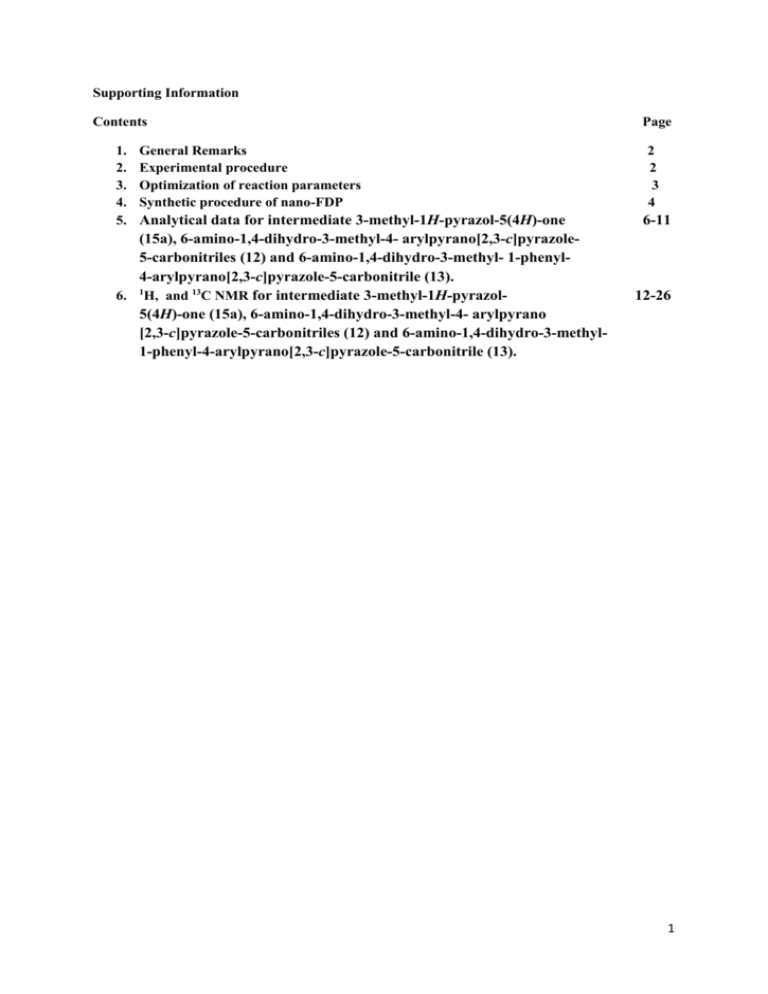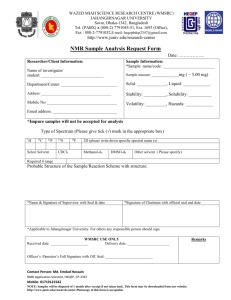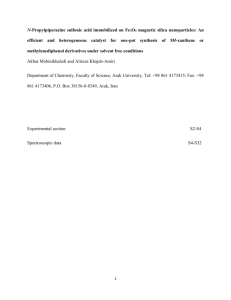Magnetically recyclable Nano-FDP
advertisement

Supporting Information Contents Page 1. 2. 3. 4. 5. 2 2 3 4 General Remarks Experimental procedure Optimization of reaction parameters Synthetic procedure of nano-FDP Analytical data for intermediate 3-methyl-1H-pyrazol-5(4H)-one (15a), 6-amino-1,4-dihydro-3-methyl-4- arylpyrano[2,3-c]pyrazole5-carbonitriles (12) and 6-amino-1,4-dihydro-3-methyl- 1-phenyl4-arylpyrano[2,3-c]pyrazole-5-carbonitrile (13). 6. 1H, and 13C NMR for intermediate 3-methyl-1H-pyrazol5(4H)-one (15a), 6-amino-1,4-dihydro-3-methyl-4- arylpyrano [2,3-c]pyrazole-5-carbonitriles (12) and 6-amino-1,4-dihydro-3-methyl1-phenyl-4-arylpyrano[2,3-c]pyrazole-5-carbonitrile (13). 6-11 12-26 1 Magnetically recyclable Nano-FDP: A novel, efficient nanoorganocatalyst for the one-pot, multi-component synthesis of pyran derivatives in water under ultrasound irradiation Binoyargha Dam , Mithu Saha and Amarta Kumar Pal * Centre for advanced studies in chemistry, North-Eastern Hill University, Shillong-793022, Meghalaya, India. GENERAL REMARKS:Melting points were determined in open capillaries and are uncorrected. IR spectra were recorded on Spectrum BX FT-IR, Perkin Elmer (υmax in cm-1) on KBr disks. 1H NMR and 13C NMR (400, 300 MHz and 100 MHz respectively) spectra were recorded on Bruker Advance II-400 and 300 spectrometer in CDCl3 and (CH3)2SO-d6 (chemical shifts in δ with TMS as internal standard). Mass spectra were recorded on Waters ZQ-4000 and maXis impact while CHN were recorded on CHN-OS analyser (Perkin Elmer 2400, Series II).Transmission Electron Microscope (TEM) was recorded on JEOL JSM 100CX, scanning electron microscope (SEM) was recorded on JSM-6360 (JEOL). EDX was recorded by using INCA Penta FET x-ray instrument. Silica gel G (E-mark, India) was used for TLC. Ultrasonicator model: RK52H, Incarp Germany (50/60 Hz, 60/240W) was used for experiments. EXPERIMENTAL PROCEDURE:Preparation of pyran derivatives:Firstly, ethylacetoacetate (1 mmol) and hydrazine hydrate (1.5 mmol) were mixed together to witness immediate formation of 3-methyl-1H-pyrazol-5(4H)-one, which is a white colored solid. The solid was then dissolved in water (10 ml) followed by addition of arylaldehydes (1 mmol) and malononitrile (1mmol) in to it. The reaction mixture was then sonicated at room temperature with nano-FDP (0.006 g). Within 2-12 min (Table-1), total conversion of the starting materials to desired product was observed. After completion of the reaction (monitored by TLC), reaction mixture was extracted with ethylacetate and nano-FDP was removed from the reaction mixture by using an external magnet. Then the recovered nanoFDP was washed with ethanol, acetone and dried. This was then reused in further reactions. The combined organic extract was washed with water (3 x 10 ml), brine and dried (anhydrous Na2SO4). Organic extract was removed under vacuum. The crude reaction mass was purified by column chromatography using ethyl acetate and hexane as eluent. 2 OPTIMIZATION OF REACTION PARAMETERS:Solubility of all the reactants played an essential part on the total effectiveness of the reaction. For example in presence of DCM and chloroform the yield of the product was very poor, this might be because of the less solubility of 3-methyl-1Hpyrazol-5(4H)-one (15a) in DCM and chloroform. Whereas, in ethanol and water, where solubility of 3-methyl1Hpyrazol-5(4H)-one (15a) is very good, lead to formation of the desired product in good to excellent yield (Fig.SI-1). The reaction mixture was ultrasonicated in presence of different solvents. 120 100 80 60 40 20 0 96 98 50 30 12 15 Yield (%) Fig.SI-1. Solvent standardization under ultrasonication Yield ( % ) Fig.SI-2. Time variation 120 100 80 60 40 20 0 0 0.005 0.01 Catalyst Concentration (g) 0.015 Fig. SI-3. Catalyst loading GENERAL METHOD FOR THE SYNTHESIS NANO-FDP (7):- 3 A. Preparation of supermagnetic Fe3O4 nanoparticles (NPs) (1) 37 A mixture of 3.4 g of ferric nitrate and 3 g of ferrous sulphate was taken in a 250 ml round bottom flask, 100 ml of deionized water was added to it and stirred for 10 min. NH4OH (25 %) was then added slowly to the reaction mixture till the pH becomes 10. After that, the reaction mixture was heated at 50-60 0C for 1 h till the black precipitate appeared, it was then seperated, washed with water till the pH became neutral (pH = 7) and dried in oven for 5 h. FeNO2 H2O, NH4OH(25 %) 0 50-60 C, 1 h Fe2SO4 Fe3O4 NPs 1 SI Scheme 1: Synthesis of Fe3O4 nanoparticles. B. BOC-Protection of L-proline (5) 1 g of L-proline (4) in a saturated solution of NaHCO3 (16 ml) was stirred in ice bath for 15 min. A mixture of BOC-anhydride (2.5 ml) and THF (6 ml) was added slowly in to it and stirred for another 19 h at room temperature. THF was removed under vacuum and the residual solution was cooled to 0 0C and acidified with 3N HCl to maintain pH 2-3. Reaction mixture was extracted with ethyl acetate (3 x 10 ml). The combined organic layer was washed with water, brine and dried over anhydrous sodium sulphate. The organic extract was concentrated under reduced pressure to yield desired product (5). C. Synthesis of Fe3O4 –DOPA nanoparticles (3)38 For accomplishing this step, we first took 2g of synthesized Fe3O4 nanoparticles (1) and dispersed it in 25 ml of deionized water by sonication at room temperature for 30 min. Dopamine hydrochloride (2g) was dissolved in 5 ml of deionized water and then added to it and ultrasonicated for another 2h. The dopamine coated Fe3O4 nanoparticles (3) was precipitated by using acetone, isolated by an external magnet and dried. NH2 NH2 NH2 HO Fe3O4 NPs HO NH2 Sonication, 2.5 h Room temperature, deionized water Fe3O4 NPs H 2N O = O NH2 NH2 NH2 NH2 3 SI Scheme 2: Synthesis of Fe3O4-DOPA 4 D. Binding of BOC-L-proline with Fe3O4-DOPA nanoparticles via amide bond formation (6) A mixture of 0.04 ml DIPEA, 174 mg of HBTU in dry DMF (5ml) was added dropwise to a solution of BOC-L-proline (5) (100 mg) in dry DMF (10 ml), and stirred at room temperature for 1 h. Then Fe3O4-DOPA nanoparticles (3) (88 mg) was added to it and stirring was continued for 24 h at room temperature. After that the desired product (6) was separated from the reaction mixture by external magnetic field, washed with acetone and dried. DIPEA+ HBTU in dry DMF Fe3O4-DOPA NPs BOC-L-Proline 1h, r.t 24 h, r.t Fe3O4 NPs O HN O 6 N O BOC SI Scheme 3: Synthesisof Fe3O4-DOPA-BOC-L-proline NPs (6) E. Deprotection of BOC from Fe3O4-DOPA-BOC-L-proline nanoparticles (6) To a solution of BOC-L-proline-Fe3O4-DOPA nanoparticles (6) (84 mg) in DCM (15 ml), TFA (1.5 ml) was added and stirred for 1 h at room temperature. After stirring, the excess solvent was removed under reduced pressure. Following that, the resulting mixture was neutralized with saturated NaHCO3 solution. The desired nano-FDP (7) was separated by external magnet, washed with acetone and dried in oven for 12 h. Analytical data for intermediate 3-methyl-1H-pyrazol-5(4H)-one (15a), 6-amino-1,4dihydro-3-methyl-4- arylpyrano[2,3-c]pyrazole-5-carbonitriles (12) and 6-amino-1,4dihydro-3-methyl- 1-phenyl-4-arylpyrano[2,3-c]pyrazole-5-carbonitrile (13). Intermediate: 3-methyl-1H-pyrazol-5(4H)-one (15a): 5 HN N O White solid . M.p. 222-224°C. IR (KBr): 3434, 1623 Cm-1. 1H NMR (DMSO-d6+ CDCl3, 400 MHz): δ = 7.71 (s, 1H), 2.17 (s, 2H), 1.25 (s, 3H). 1. Compound 12a Cl CN NH2 N N H O Yellow solid. IR (KBr): 3396, 3356, 3199, 2216 cm-1. 1H NMR (DMSO-d6, 400 MHz): δ = 12.15 (s, 1H), 7.38 (d, J = 8.0 Hz, 2H), 7.20 (d, J = 8.0 Hz, 2H), 6.93 (s, 2H), 4.63 (s, 1H), 1.78 (s, 3H). 13C NMR (DMSO-d6, 100MHz): δ= 160.6, 143.1, 139.8, 129.7, 129.3, 127.4, 103.3, 55.9, 32.4, 10.6. ESI-MS: m/z 287, 289 [M+H]+. Anal. Calcd. for C14H11ClN4O: C, 58.65; H, 3.87; N, 19.54. Found: C, 58.73; H, 3.66; N, 19.67. 2. Compound 12b O2N CN NH2 N N H O Yellow solid. IR (KBr): 3288, 3231, 3125, 2196 cm-1. 1H NMR (DMSO-d6, 400 MHz): δ = 11.81 (s, 1H), 7.60 (d, J = 8.8 Hz, 2H), 7.01 (d, J = 8.8 Hz, 2H), 6.55 (s, 2H), 4.35 (s, 1H), 1.33 (s, 3H). 13C NMR (DMSO-d6, 100MHz): δ= 161.0, 151.7, 146.3, 145.5, 128.7, 123.8, 122.9, 103.1, 35.8, 32.8, 10.2. ESI-MS: m/z 298 [M+H]+. Anal. Calcd. for C14H11N5O3: C, 56.56; H, 3.73; N, 23.56. Found: C, 56.31; H, 3.75; N, 23.50. 6 3. Compound 12c H3C CN NH2 N N H O Yellow solid. IR (KBr): 3408, 3316, 3191, 2193 cm-1. 1H NMR (DMSO-d6, 400 MHz): δ = 12.08 (s, 1H), 7.11-7.01 (m, 4H), 6.84 (s, 2H), 4.52 (s, 1H), 2.25 (s, 3H), 1.76 (s, 3H). 13C NMR (DMSO-d6, 100MHz): δ= 160.7, 154.7, 141.4, 135.6, 135.5, 128.9, 127.3, 120.7, 97.6, 57.2, 38.7, 20.5, 9.7. ESI-MS: m/z 267 [M+H]+. Anal. Calcd. for C15H14N4O: C, 67.65; H, 5.30; N, 21.04. Found: C, 67.57; H, 5.45; N, 20.87. 4. Compound 13a White solid. IR (KBr): 3476, 3330, 2196 cm-1. 1H NMR (DMSO-d6, 400 MHz): δ = 7.72 (d, J = 8.0 Hz, 4H), 7.45-7.38 (m, 5H), 7.26-7.17 (m, 3H), 4.92 (s, 1H), 2.49 (s, 3H). 13C NMR (DMSO-d6, 100MHz): δ= 153.5, 146.2, 142.3, 128.8, 128.0, 127.1, 125.8, 125.4, 120.4, 82.2, 33.0, 11.6. ESI-MS: m/z 329 [M+H]+. Anal. Calcd. for C20H16N4O: C, 73.15; H, 4.91; N, 17.06. Found: C, 73.30; H, 5.05; N, 16.97. 5. Compound 13b 7 Yellow solid. IR (KBr): 3475, 3326, 2196 cm-1. 1H NMR (CDCl3+DMSO-d6, 400 MHz): δ = 7.68 (d, J = 8.0 Hz, 2H), 7.45 (t, J = 8.0 Hz, 2H), 7.29-7.25 (m, 1H), 7.11 (s, 4H), 5.48 (s, 2H), 4.58 (s, 1H), 2.30 (s, 3H), 1.86 (s, 3H). 13C NMR (CDCl3+DMSO-d6, 100MHz): δ= 158.8, 145.5, 143.6, 139.4, 137.3, 136.1, 128.78, 128.70, 127.2, 125.8, 120.2, 119.7, 98.1, 60.1, 36.5, 20.5, 12.4. ESI-MS: m/z 343 [M+H]+. Anal. Calcd. for C21H18N4O: C, 73.67; H, 5.30; N, 16.36. Found: C, 73.38; H, 5.37; N, 16.49. 6. Compound 13c White solid. IR (KBr): 3420, 3310, 2196 cm-1. 1H NMR (CDCl3+DMSO-d6, 400 MHz): δ = 7.58 (d, J = 8.0 Hz, 1H), 7.42 (t, J = 7.8 Hz, 2H ), 7.27 (t, J = 7.4 Hz, 1H), 7.18-7.14 (m, 3H), 7.00 (t, J = 8.6 Hz, 2H), 4.64 (s, 2H), 4.60 (s, 1H), 1.81 (s, 3H). 13C NMR (CDCl3+DMSO-d6, 100MHz): δ= 167.6, 165.2, 164.4, 150.4, 148.9, 144.1, 142.6, 134.48, 134.40, 134.0, 131.0, 125.2, 120.0, 103.1, 63.8, 41.5, 17.7. ESI-MS: m/z 347 [M+H]+. Anal. Calcd. for C20H15FN4O: C, 69.35; H, 4.37; N, 16.18. Found: C, 69.42; H, 4.40; N, 16.20. 7. Compound 13d 8 Yellow solid. IR (KBr): 3462, 3376, 2230 cm-1. 1H NMR (CDCl3+DMSO-d6 400 MHz): δ = 8.15 (d, J = 8.8 Hz, 2H), 7.72 (d, J = 8.0 Hz, 2H), 7.45-7.38 (m, 4H), 7.25 (t, J = 7.4 Hz, 1H), 6.89 (s, 2H), 4.74 (s, 1H), 1.78 (s, 3H). 13 C NMR (CDCl3+DMSO-d6, 100 MHz): δ = 159.4, 150.3, 146.5, 145.0, 143.8, 137.2, 128.8, 128.6, 125.9, 123.4, 120.1, 119.4, 96.9, 57.4, 36.8, 12.4. ESI-MS: m/z 374 [M+H]+. Anal. Calcd. for C20H15N5O3: C, 64.34; H, 4.05; N, 18.76. Found: C, 64.52; H, 4.12; N, 18.89. 8. Compound 13e White solid. IR (KBr): 3456, 3330, 2196 cm-1. 1H NMR (CDCl3+DMSO-d6, 400 MHz): δ = 7.65 (d, J = 8.0 Hz, 2H), 7.41-7.37 (m, 4H), 7.25 (t, J = 7.2 Hz, 1H), 7.09 (d, J = 8.4 Hz, 2H), 5.96 (s, 2H), 4.55 (s, 1H), 1.81(s, 3H). 13 C NMR (CDCl3+DMSO-d6, 100 MHz): δ = 200.4, 167.7, 163.7, 155.0, 137.1, 133.4, 124.4, 123.6, 117.2, 114.8, 62.3, 55.1, 41.0, 36.9, 33.6, 32.2. ESI-MS: m/z 407, 409 [M+H]+. Anal. Calcd. for C20H15BrN4O: C, 58.98; H, 3.71; N, 13.76. Found: C, 58.73; H, 3.60; N, 13.61. 9. Compound 13f 9 White solid. IR (KBr): 3456, 3370, 2203 cm-1. 1H NMR (CDCl3, 400 MHz): δ = 7.58 (d, J = 8.0 Hz, 2H), 7.42 (t, J = 7.4 Hz, 3H), 7.27 (d, J = 8.4 Hz, 2H), 7.14 (d, J = 8.4 Hz, 2H), 4.66 (s, 2H), 4.58 (s, 1H), 1.82 (s, 3H). 13 C NMR (CDCl3, 100 MHz): δ = 158.2, 146.2, 143.7, 140.5, 137.4, 133.4, 129.3, 129.2, 129.0, 126.9, 121.2, 118.9, 97.8, 63.2, 36.8, 12.9. ESI-MS: m/z 363, 365 [M+H]+. Anal. Calcd. for C20H15ClN4O: C, 66.21; H, 4.17; N, 15.44. Found: C, 66.36; H, 4.31; N, 15.35. 10. Compound 13g Off-white solid. IR (KBr): 3429, 3400, 2369 cm-1. 1H NMR (CDCl3 + DMSO-d6, 400 MHz): δ = 7.79 (d, J = 8.0 Hz, 2H), 7.71 (d, J = 8.0 Hz, 2H), 7.48-7.43 (m, 4H), 7.31 (t, J = 7.4 Hz, 1H), 6.93 (s, 2H), 4.74 (s, 1H), 1.84 (s, 3H). 13 C NMR (CDCl3+DMSO-d6, 100 MHz): δ = 164.6, 153.4, 150.3, 149.0, 142.4, 137.3, 134.0, 133.7, 131.1, 125.3, 124.6, 123.4, 115.5, 102.2, 62.8, 42.3, 17.7. ESI-MS: m/z 354 [M+H]+. Anal. Calcd. for C21H15N5O: C, 71.38; H, 4.28; N, 19.82. Found: C, 71.16; H, 4.52; N, 19.88. 11. Compound 13h 10 Yellow solid. IR (KBr): 3456, 3363, 2190 cm-1. 1H NMR (CDCl3+DMSO-d6, 400 MHz): δ = 8.09-8.03 (m, 2H), 7.67 (d, J = 8.0 Hz, 2H ), 7.61 (d, J = 7.6 Hz, 1H), 7.52 (t, J = 7.8 Hz, 1H ), 7.42 (t, J = 7.8 Hz, 2H), 7.21 (t, J = 7.2 Hz, 1H), 6.08 (s, 2H), 4.73 (s, 1H), 1.80 (s, 3H). ). 13C NMR (CDCl3+DMSO-d6, 100 MHz): δ = 159.4, 147.9, 145.1, 137.2, 133.9, 129.4, 128.7, 125.9, 122.1, 121.9, 120.1, 119.4, 96.9, 57.7, 38.9, 36.7, 12.5. ESI-MS: m/z 374 [M+H]+. Anal. Calcd. for C20H15N5O3: C, 64.34; H, 4.05; N, 18.76. Found: C, 64.26; H, 4.16; N, 18.62. 12. Compound 13i Off-white solid. IR (KBr): 3389, 3214, 2192 cm-1. 1H NMR (DMSO-d6, 400 MHz): δ = 7.85 (s, 2H), 7.75 (d, J = 8.0 Hz, 2H), 7.51-7.44 (m, 4H), 7.37-7.26 (m, 3H), 5.19 (s, 1H), 2.34 (s, 3H). 13 C NMR (DMSO-d6, 100 MHz): δ = 166.7, 145.8, 139.4, 131.7, 130.1, 129.3, 128.8, 127.9, 126.8, 125.5, 120.6, 108.0, 106.8, 79.5, 31.5, 11.8. ESI-MS: m/z 363, 365 [M+H]+. Anal. Calcd. for C20H15ClN4O: C, 66.21; H, 4.17; N, 15.44. Found: C, 66.08; H, 4.08; N, 15.29. 11 1 H, and 13C NMR for intermediate 3-methyl-1H-pyrazol-5(4H)-one (15a), 6-amino-1,4- dihydro-3-methyl-4- arylpyrano[2,3-c]pyrazole-5-carbonitriles (12) and 6-amino-1,4dihydro-3-methyl-1-phenyl-4-arylpyrano[2,3-c]pyrazole-5-carbonitrile (13) 1H NMR datas :- 12 13 14 15 16 17 18 13 C NMR datas :- 19 20 21 22 23 24 25 26





